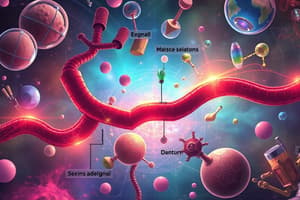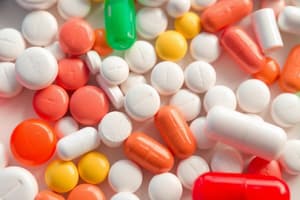Podcast
Questions and Answers
What is the primary focus of pharmacodynamics?
What is the primary focus of pharmacodynamics?
- Drug absorption rates
- How the body affects drugs
- Drug distribution methods
- The effects of drugs on the body (correct)
Which phase of drug metabolism involves the addition of another substance?
Which phase of drug metabolism involves the addition of another substance?
- Phase IV: Absorption
- Phase I: Modification
- Phase III: Excretion
- Phase II: Conjugation (correct)
What type of adverse drug reaction is characterized by an immune response to a drug?
What type of adverse drug reaction is characterized by an immune response to a drug?
- Side effects
- Allergic reactions (correct)
- Toxic reactions
- Therapeutic effects
Which of the following routes is NOT commonly considered a method of drug absorption?
Which of the following routes is NOT commonly considered a method of drug absorption?
What does the therapeutic index indicate about a drug?
What does the therapeutic index indicate about a drug?
What is the main objective of preclinical testing in drug development?
What is the main objective of preclinical testing in drug development?
Which type of drug action actively stimulates receptors?
Which type of drug action actively stimulates receptors?
What does bioavailability refer to in pharmacology?
What does bioavailability refer to in pharmacology?
Study Notes
Overview of Pharmacology
- Definition: Study of drugs, their actions, effects, and mechanisms in the body.
- Subfields:
- Pharmacokinetics: How the body affects a drug (absorption, distribution, metabolism, excretion).
- Pharmacodynamics: How a drug affects the body (mechanism of action, effects).
Drug Classification
- By Source:
- Natural (plants, animals).
- Synthetic (chemically manufactured).
- By Therapeutic Use:
- Analgesics (pain relief).
- Antibiotics (infection control).
- Antidepressants (mood regulation).
- By Mechanism of Action:
- Agonists (activate receptors).
- Antagonists (block receptors).
Pharmacokinetics
- Absorption: Process of drug entering the bloodstream.
- Routes: Oral, intravenous, intramuscular, subcutaneous.
- Distribution: Dispersion of drugs throughout body fluids and tissues.
- Factors: Blood flow, protein binding, tissue permeability.
- Metabolism: Biochemical modification of drugs, primarily in the liver.
- Phase I: Modification (oxidation, reduction).
- Phase II: Conjugation (addition of another substance).
- Excretion: Elimination of drugs from the body, mainly via kidneys.
Pharmacodynamics
- Mechanism of Action: Interaction of drug with target molecules (receptors, enzymes).
- Dose-Response Relationship: Correlation between drug dose and its pharmacological effect.
- Therapeutic Index: Ratio of toxic dose to effective dose; higher values indicate safer drugs.
Adverse Drug Reactions
- Types:
- Side effects: Unwanted effects that occur at therapeutic doses.
- Allergic reactions: Immune response to a drug.
- Toxic reactions: Harmful effects occurring at high doses.
- Factors Influencing Reactions:
- Patient-specific factors (age, sex, genetics).
- Drug interactions (synergistic, antagonistic effects).
Drug Development Process
- Discovery: Identification of potential drug compounds.
- Preclinical Testing: Laboratory and animal studies for safety and efficacy.
- Clinical Trials: Human testing in three phases (Phase I: safety, Phase II: efficacy, Phase III: comparison).
- Regulatory Approval: Submission to health authorities for drug approval.
- Post-Marketing Surveillance: Monitoring drug effects in the general population.
Important Concepts
- Bioavailability: Fraction of administered drug that reaches systemic circulation.
- Half-life: Time taken for the plasma concentration of a drug to reduce by half.
- Drug Interactions: Effects that occur when one drug influences the activity of another.
Commonly Used Drugs
- Analgesics: Acetaminophen, Ibuprofen.
- Antibiotics: Penicillin, Amoxicillin.
- Antihypertensives: Lisinopril, Amlodipine.
- Antidepressants: Fluoxetine, Sertraline.
Ethical Considerations
- Informed Consent: Patients must be informed about treatment risks and benefits.
- Off-label Use: Prescribing drugs for unapproved indications must be done cautiously.
- Access and Equity: Ensuring fair access to medications for all populations.
Overview of Pharmacology
- Study of drugs, their effects, actions, and mechanisms within the body.
- Subfields include:
- Pharmacokinetics: How the body processes a drug (absorption, distribution, metabolism, excretion).
- Pharmacodynamics: How a drug influences the body (mechanisms and effects).
Drug Classification
- By Source:
- Natural: Derived from plants or animals.
- Synthetic: Manufactured through chemical processes.
- By Therapeutic Use:
- Analgesics: Medications for pain relief.
- Antibiotics: Drugs for combating infections.
- Antidepressants: Medications aimed at mood stabilization.
- By Mechanism of Action:
- Agonists: Activate specific receptors in the body.
- Antagonists: Block the action of receptors.
Pharmacokinetics
- Absorption: Entry of drugs into the bloodstream through various routes such as oral, intravenous, intramuscular, and subcutaneous.
- Distribution: Spread of drugs throughout body fluids and tissues influenced by factors like blood flow and protein binding.
- Metabolism: Biochemical alterations of drugs, mainly occurring in the liver with Phase I modifications (oxidation/reduction) and Phase II conjugation (addition of substances).
- Excretion: Removal of drugs from the body, primarily through the kidneys.
Pharmacodynamics
- Mechanism of Action: Drug interaction with target molecules such as receptors or enzymes.
- Dose-Response Relationship: Link between the dosage of a drug and its pharmacological impact.
- Therapeutic Index: Comparison of toxic dose to effective dose; a higher index indicates a safer drug profile.
Adverse Drug Reactions
- Types of Reactions:
- Side effects: Undesired effects occurring at therapeutic doses.
- Allergic reactions: Immune responses provoked by drugs.
- Toxic reactions: Harmful effects appearing at elevated doses.
- Influencing Factors:
- Individual variations (age, sex, genetic makeup).
- Drug interactions, either synergistic or antagonistic in nature.
Drug Development Process
- Discovery: Initial identification of potential drug compounds.
- Preclinical Testing: Safety and efficacy evaluation through laboratory and animal studies.
- Clinical Trials: Human testing in three phases:
- Phase I: Safety assessment.
- Phase II: Efficacy testing.
- Phase III: Comparison with existing treatments.
- Regulatory Approval: Submission process for drug approval to health authorities.
- Post-Marketing Surveillance: Continual monitoring of drug effects post-approval in the general population.
Important Concepts
- Bioavailability: Percentage of administered drug that enters systemic circulation.
- Half-life: Duration for the plasma concentration of a drug to reduce to half its original amount.
- Drug Interactions: Alterations in drug effectiveness when combined with other substances.
Commonly Used Drugs
- Analgesics: Examples include Acetaminophen and Ibuprofen.
- Antibiotics: Common drugs include Penicillin and Amoxicillin.
- Antihypertensives: Medications like Lisinopril and Amlodipine.
- Antidepressants: Typical examples are Fluoxetine and Sertraline.
Ethical Considerations
- Informed Consent: Patients should be made aware of the risks and benefits of treatments.
- Off-label Use: The practice of prescribing medications for unapproved uses should be approached with caution.
- Access and Equity: Emphasis on ensuring fair availability of medications across different populations.
Studying That Suits You
Use AI to generate personalized quizzes and flashcards to suit your learning preferences.
Description
Explore the key concepts of pharmacology, including the definitions and the subfields of pharmacokinetics and pharmacodynamics. Understand how drugs are classified by source, therapeutic use, and mechanism of action. This quiz will assess your knowledge on how drugs interact within the body and their various applications.



